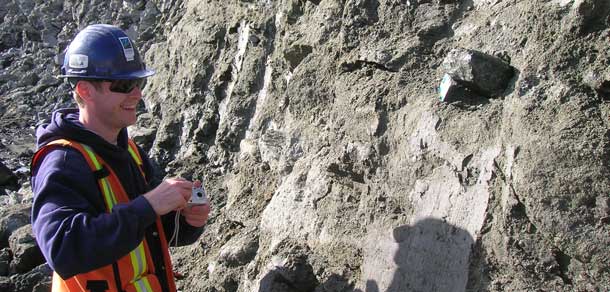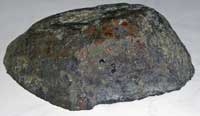Gus Fomradas, P.Geo, is a Technical Manager with Rio Tinto Exploration Canada Inc.
I had just started a new job as a Mine Geologist at Diavik Diamond Mine and had only been there a few days. My cross shift had stayed to show me around but left with my supervisor before my first weekend at site. It was a bit intimidating, but also exciting to be the only geologist on site and have that responsibility and accountability.
During a routine pit-mapping session the next day, I walked up to a small, freshly blasted and only partially dug kimberlite ore muck pile. As I was getting ready to carry on with my daily routine, I noticed a small, polished surface of a rock about five centimeters in diameter that stood out amongst its kimberlite host.
I chipped a small amount of kimberlite away from this very slightly protruding rock only to discover it was growing and getting larger. I continued to mine this rock out to discover it was a magnificent large eclogite.
Eclogite
I was quite excited as there was an impressive collection of mantel xenoliths in the office and a little competition as to who could find the largest one. After weighing this xenolith, I returned to the office to check the scoreboard.
Being an eager and keen geologist, I made up a little report of this find with a picture of the rock on the scale and sent it to my supervisor. He then reminded me to “watch yourself, you are still on probation” when I noted I had bumped him from the top spot on the scoreboard.
Before coming to work at the mine, I had previously only seen these mantle xenoliths in drill core. Walking across the entire width of a kimberlite with these unique preserved specimens from the mantle was quite surreal.
I had known of their importance as a diamond exploration geologist – the disaggregation of their minerals, often garnets and chrome rich pyroxenes, were key indicator minerals sought after during till sampling in diamond exploration.
The analysis of the chemistry of these indicators could help indicate if they had the potential to be from a kimberlitic source and therefore further imply diamond potential. There was no better indication of diamond potential, however, than to find an eclogite containing diamonds and a rock such as this. It happens to be one of my favourites.

